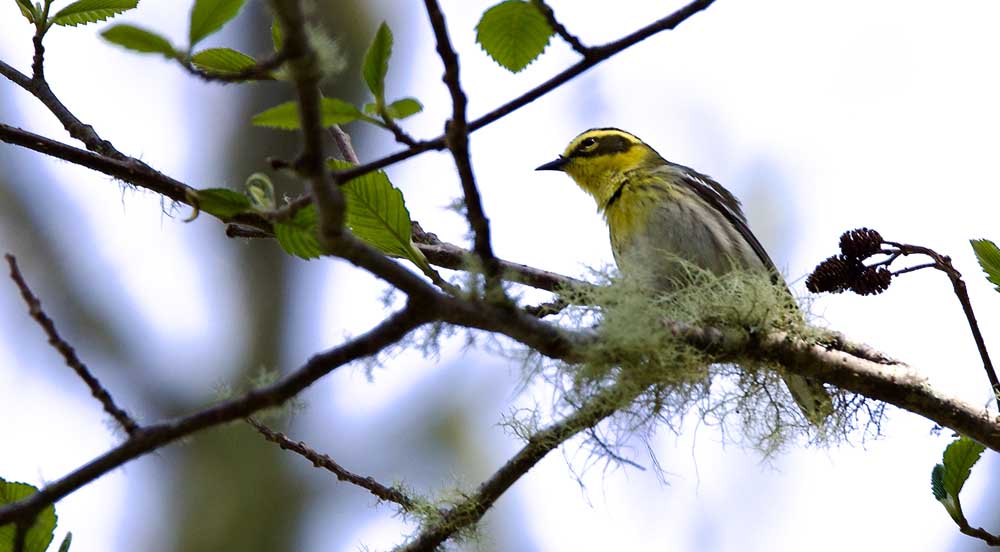Birding: Watch for wonderful warblers
Published 9:00 am Saturday, May 13, 2023

- Townsend’s warbler has been seen in large numbers this past winter and this spring.
The spring arrival of the wood warblers is the highlight for many birders. It certainly is for me! These tiny songsters are diverse but in general share similar shapes, are all small and have long, thin bills they use for snatching insects. They are all colorful and magical looking.
Trending
The field checklist of birds for the Willapa National Wildlife Refuge and the Long Beach Peninsula indicates that we can see at least seven different warbles for sure, four rarities which means they are seen every two to five years. In addition, there are two species, the blue-winged warbler and the blackburnian warbler for which there are five records or less. Thus, they are considered accidentals.
The seven warblers we can see for sure include, the orange-crowned warbler, common yellowthroat, yellow-rumped warbler, yellow warbler, black-throated gray warbler, Townsend’s warbler, and the Wilson’s warbler. The rarer species includes the palm warbler, hermit warbler, yellow-breasted chat and MacGillivray’s warbler. To be sure, it is lucky to be able to see the rarer songbirds. I was lucky enough to see one MacGillivray’s during the first week of May. So, it is possible to see a rarity. The palm warbler is most often seen in our area in the fall and winter. The other three rarities are more likely to be seen as spring or fall migrants. To my knowledge, none of these four have ever been documented as a nesting species here.
The seven more likely species are considered common for the most part. The yellow-rumped warbler being one of the most common and considered a permanent resident, along with the orange-crowned, and the common yellowthroat. Wilson’s warbler is common from spring until the fall and has been documented as a nesting species. The yellow-rumped can be either of the myrtle or the Audubon’s species. They were recently classified as one species. The former has a white throat. The Audubon’s has a yellow throat and is more common in the west than the myrtle version of the yellow-rumped. The myrtle species is most common in the east. The yellow-rumped warbler is nicknamed the butter butt. Look for its yellow rump. Dr. David Bird (2019) suggest that recent evidence indicates that they may indeed be separate species. If so, they will become separate species once again.
Trending
Townsend’s warbler, however, is not a documented nester even though my records indicate that it is with us in every season. The largest numbers seem to be seen in the winter and spring. This past winter Cape D birders produced many reports of large flocks of Townsend’s, and I have been seeing many in the evergreens in our yard so far this spring. Orange-crowned warblers are permanent residents in our area. Not all of them will stay for the winter. Science tells us that while some winter in the west, the rest will go to Mexico and Guatemala.
The yellow warbler is one of the most widely distributed warblers in North America. According to scientists it breeds throughout the United States except in the southern most states where it is a migrant (Backyard Birds, 2021). This songbird prefers stream and woodland edges, and areas where willows grow. Brushy habitats are its favorite. Like some other relatively small songbirds it is often the victim of the brown-headed cowbird. However, this bird is smart. If a cowbird egg is laid in its nest, it will construct a new lining over the egg. The female yellow warbler incubates the eggs but both parents feed the nestlings.
Warblers never eat seeds! They are insect and nectar eaters for the most part. Trees, shrubs, and native plants that encourage healthy insect populations and not using pesticides will help entice warblers to your yard. Some warblers will puncture the base of a flower to get nectar, some will visit hummingbird feeders and occasionally eat berries. A water feature or birdbath will also attract warblers to your yard. One thing to remember though is that we need to bring in our feeders at night so as not to tempt the bears that are looking for an easy meal!
Warbler voices are cheerful and sweet. The Yellow warbler’s song sounds like it is singing “sweet, sweet, shredded wheat”! Although some birders say it sounds like “sweet, sweet, I’m so sweet”. The common yellowthroat’s song sounds like it is saying, “witchity, witchity, wichity”. One of the best ways to learn a bird’s song is to find it and watch it sing. Guaranteed, you are not likely to forget the magic of the music.
The arrival of the spring warblers is indeed a highlight of spring migration. Watch for them in the coming weeks. These wonderful songbirds are like jewels. Their beauty will amaze and delight you. Happy birding!









